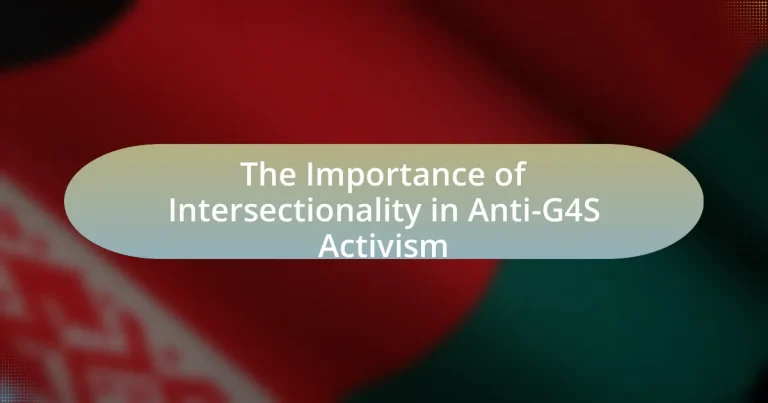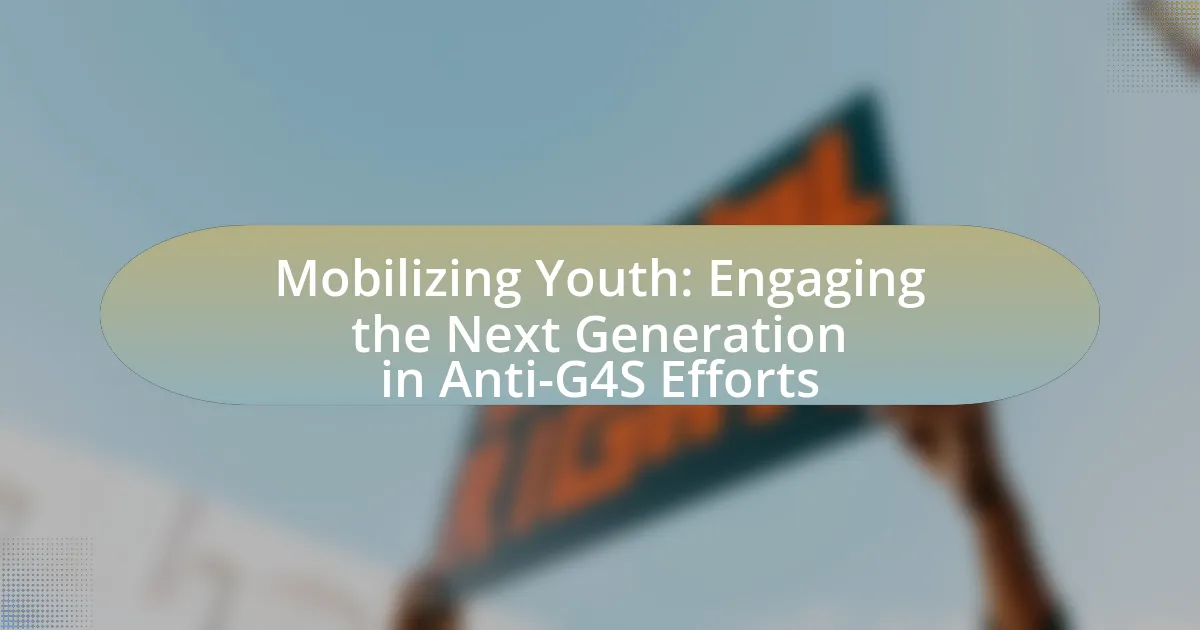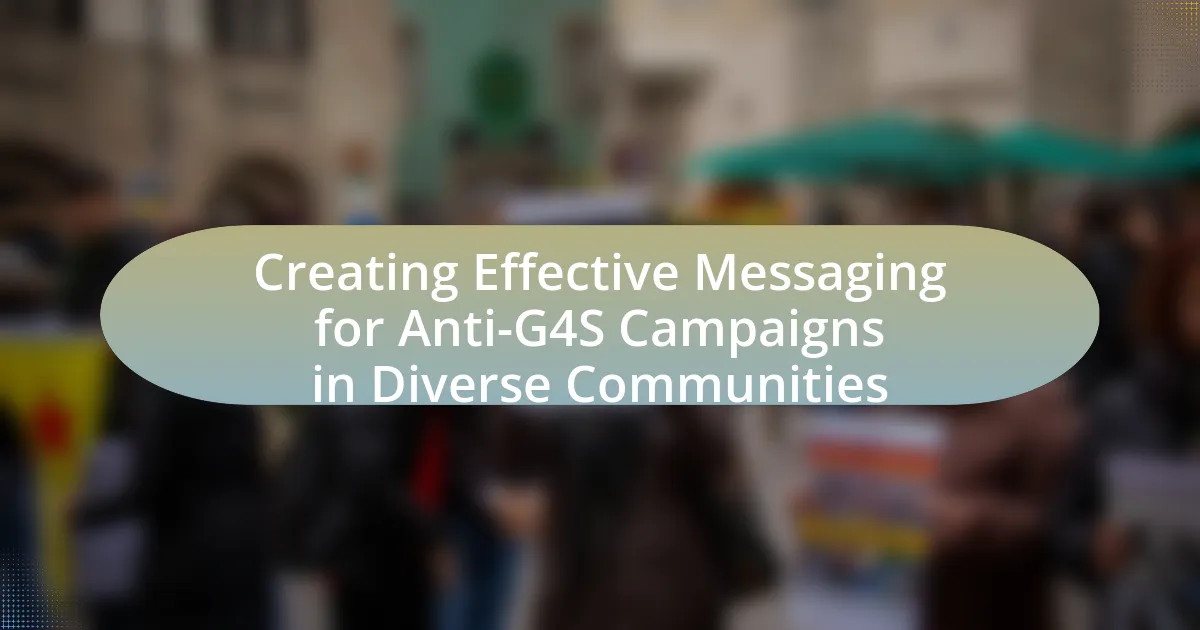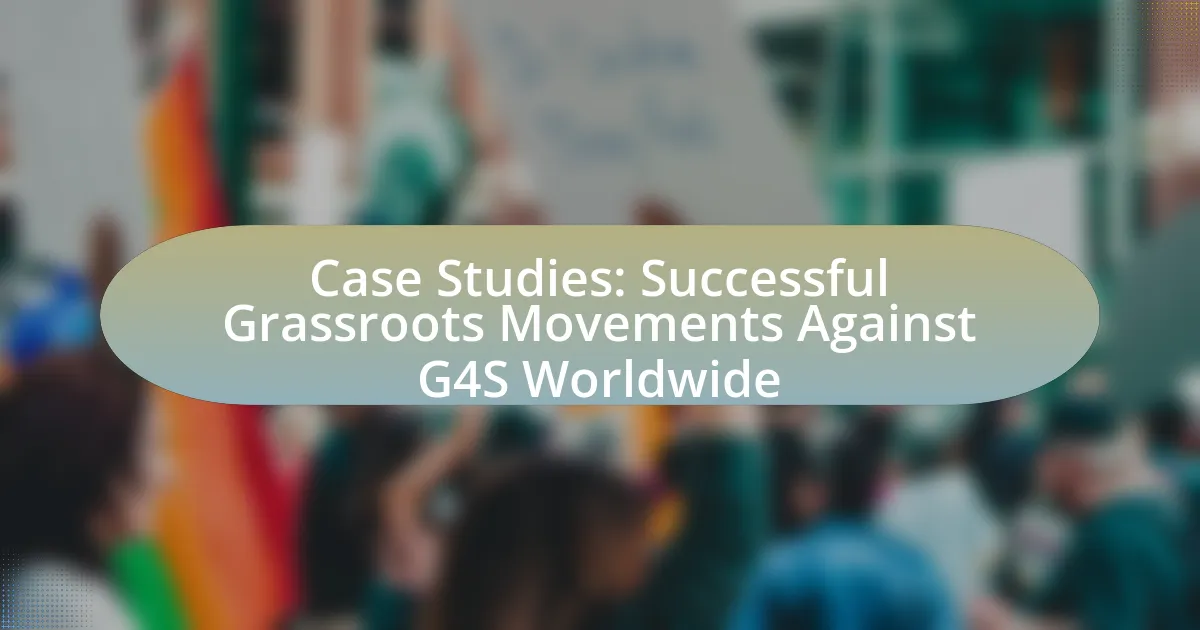The article focuses on the significance of intersectionality within anti-G4S activism, emphasizing how various social identities—such as race, gender, class, and sexuality—intersect to create distinct experiences of oppression and privilege. It explores how this framework enhances understanding of the multifaceted impacts of G4S’s operations on marginalized communities, particularly in relation to systemic inequalities. Key principles of intersectionality are outlined, along with its influence on social justice movements, the challenges activists face in implementing intersectional approaches, and strategies for fostering inclusivity and solidarity among diverse groups. The article also discusses the practical implications of intersectionality in shaping effective campaign strategies and policy advocacy against G4S.
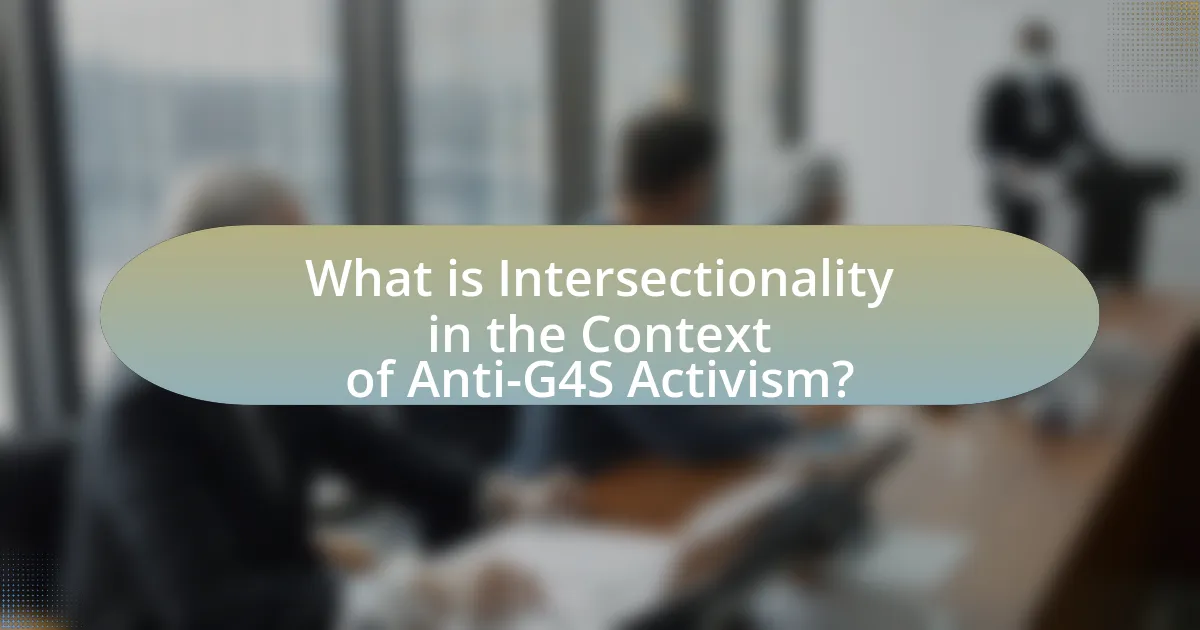
What is Intersectionality in the Context of Anti-G4S Activism?
Intersectionality in the context of anti-G4S activism refers to the framework that examines how various social identities, such as race, gender, class, and sexuality, intersect to create unique experiences of oppression and privilege. This approach is crucial for understanding the multifaceted impacts of G4S’s operations, which often exacerbate inequalities faced by marginalized communities. For instance, anti-G4S activists highlight how the company’s involvement in immigration detention disproportionately affects people of color and low-income individuals, illustrating the need for a nuanced analysis that considers these intersecting factors. By applying an intersectional lens, activists can advocate for more inclusive and effective strategies that address the specific needs and rights of diverse groups impacted by G4S’s practices.
How does intersectionality influence social justice movements?
Intersectionality significantly influences social justice movements by highlighting the interconnected nature of social categorizations such as race, gender, and class, which create overlapping systems of discrimination or disadvantage. This framework allows activists to understand that individuals experience oppression in varied and complex ways, necessitating a more inclusive approach to advocacy. For instance, the Black Lives Matter movement incorporates intersectional perspectives to address not only police violence but also the unique challenges faced by Black women and LGBTQ+ individuals within the community. Research by Crenshaw (1989) emphasizes that failing to consider these intersections can lead to inadequate solutions that overlook the specific needs of marginalized groups, thereby reinforcing systemic inequalities.
What are the key principles of intersectionality?
The key principles of intersectionality include the recognition that individuals experience overlapping social identities, which can lead to unique forms of discrimination and privilege. This framework emphasizes that social categories such as race, gender, class, sexuality, and ability do not exist independently but interact to shape individual experiences and systemic inequalities. For instance, a Black woman may face both racial and gender discrimination simultaneously, which cannot be understood by examining race or gender in isolation. Intersectionality was first coined by Kimberlé Crenshaw in 1989, highlighting the need to consider multiple identities in social justice movements to address the complexities of oppression effectively.
How does intersectionality address systemic inequalities?
Intersectionality addresses systemic inequalities by recognizing that individuals experience overlapping social identities, such as race, gender, class, and sexuality, which can compound discrimination and disadvantage. This framework highlights how various forms of oppression are interconnected, rather than isolated, allowing for a more comprehensive understanding of social injustices. For example, a study by Crenshaw (1989) demonstrated that Black women face unique challenges that are not fully addressed by either feminist or anti-racist movements alone, illustrating the necessity of an intersectional approach to effectively combat systemic inequalities.
Why is intersectionality crucial for effective anti-G4S activism?
Intersectionality is crucial for effective anti-G4S activism because it recognizes and addresses the interconnected nature of social categorizations such as race, gender, and class, which can lead to overlapping systems of discrimination and disadvantage. By applying an intersectional lens, activists can better understand how G4S’s practices disproportionately impact marginalized communities, such as people of color and low-income individuals, thereby creating more targeted and inclusive strategies for resistance. Research indicates that movements that incorporate intersectionality are more successful in mobilizing diverse coalitions and fostering solidarity among various groups, enhancing the overall impact of their activism against entities like G4S.
What unique perspectives does intersectionality bring to anti-G4S efforts?
Intersectionality brings a multifaceted understanding of how various social identities, such as race, gender, class, and sexuality, intersect to shape individuals’ experiences with systemic oppression, particularly in the context of anti-G4S efforts. This perspective highlights that the impacts of G4S’s operations are not uniform; marginalized communities often face compounded injustices due to overlapping identities. For instance, research indicates that Black women and LGBTQ+ individuals experience heightened surveillance and policing, which G4S facilitates through its security contracts. By incorporating intersectionality, activists can tailor their strategies to address these specific vulnerabilities, ensuring that anti-G4S campaigns are inclusive and effective in advocating for the rights of all affected groups.
How can intersectionality enhance solidarity among diverse groups?
Intersectionality enhances solidarity among diverse groups by recognizing and addressing the interconnected nature of social categorizations such as race, gender, and class. This framework allows individuals and groups to understand how overlapping identities contribute to unique experiences of oppression and privilege. For instance, the work of Kimberlé Crenshaw, who coined the term “intersectionality,” illustrates how Black women face discrimination that is distinct from that experienced by white women or Black men, thereby emphasizing the need for inclusive activism that considers multiple identities. By fostering a deeper understanding of these complexities, intersectionality encourages collaboration and mutual support among diverse groups, leading to more effective collective action against systemic injustices.
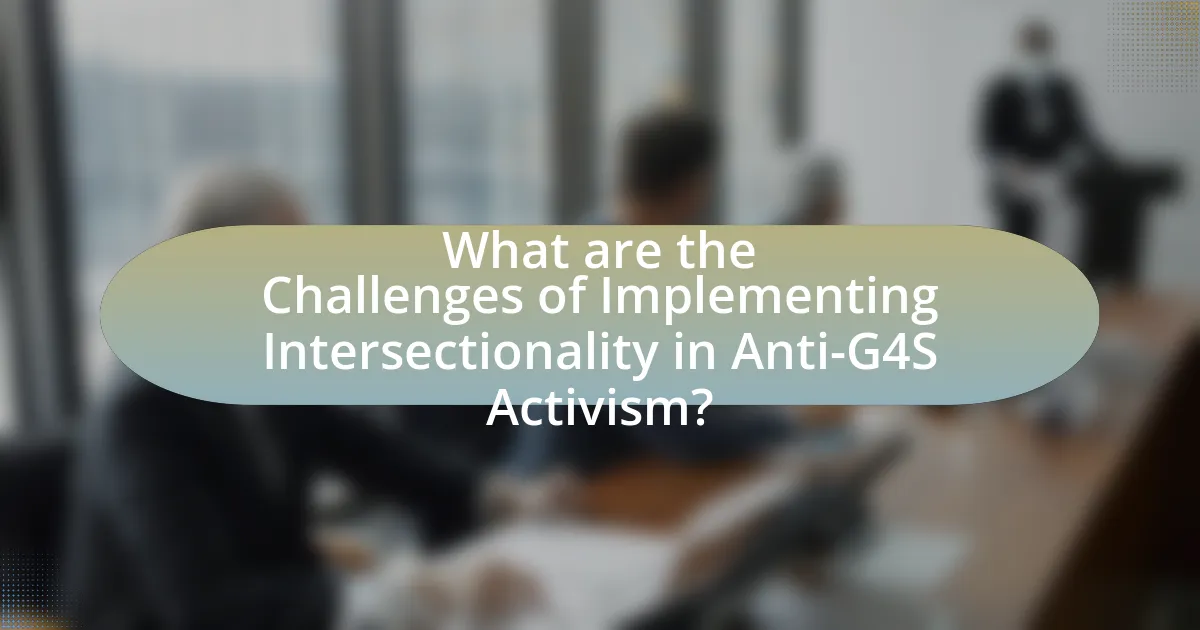
What are the Challenges of Implementing Intersectionality in Anti-G4S Activism?
The challenges of implementing intersectionality in anti-G4S activism include the difficulty of addressing diverse identities and experiences within a unified movement. Activists often struggle to balance the varying needs and priorities of different marginalized groups, which can lead to tensions and fragmentation. For instance, the intersection of race, class, gender, and other social categories complicates coalition-building, as individuals may prioritize their specific issues over collective goals. Additionally, there is a risk of tokenism, where the representation of diverse voices is superficial rather than substantive, undermining the movement’s effectiveness. These challenges highlight the necessity for ongoing dialogue and collaboration among activists to ensure that intersectional perspectives are genuinely integrated into anti-G4S efforts.
What obstacles do activists face when integrating intersectionality?
Activists face several obstacles when integrating intersectionality, including a lack of understanding among allies, limited resources, and the challenge of addressing multiple, often conflicting, identities within their movements. The complexity of intersectionality requires activists to navigate diverse social categories such as race, gender, class, and sexuality, which can lead to misunderstandings or resistance from those who may not fully grasp its significance. Additionally, activists often struggle with insufficient funding and support to implement intersectional approaches effectively, as many organizations prioritize single-issue campaigns. Research by Crenshaw (1989) highlights that without addressing these intersecting identities, movements risk marginalizing the very groups they aim to support, thus undermining their overall effectiveness.
How can misunderstandings of intersectionality hinder activism?
Misunderstandings of intersectionality can hinder activism by oversimplifying the complexities of individuals’ identities and experiences, leading to ineffective strategies that fail to address the needs of marginalized groups. When activists do not recognize how various social categories—such as race, gender, class, and sexuality—intersect, they may inadvertently prioritize one issue over others, alienating potential allies and undermining collective efforts. For example, a study by Crenshaw (1989) highlighted how Black women face unique challenges that are not adequately addressed by movements focused solely on race or gender, demonstrating that a lack of intersectional understanding can result in the exclusion of critical voices and issues from activism. This exclusion can weaken the overall impact of movements, as they may not fully represent or advocate for the diverse experiences of all community members.
What are the risks of neglecting intersectionality in activism?
Neglecting intersectionality in activism risks perpetuating systemic inequalities and marginalizing the voices of those most affected by social injustices. When activists fail to consider how various identities—such as race, gender, class, and sexuality—intersect, they may overlook the unique challenges faced by individuals at these intersections. For example, a study by the American Psychological Association highlights that marginalized groups often experience compounded discrimination, which can lead to ineffective advocacy that does not address the specific needs of these communities. This oversight can result in policies and initiatives that primarily benefit dominant groups, thereby reinforcing existing power structures and failing to create meaningful change for all.
How can activists overcome these challenges?
Activists can overcome challenges in anti-G4S activism by fostering collaboration across diverse social movements. This approach enables the integration of various perspectives and experiences, which strengthens the collective voice against systemic injustices. For instance, the Black Lives Matter movement has successfully partnered with immigrant rights organizations to address overlapping issues of racial and economic inequality, demonstrating the effectiveness of intersectional alliances. Research indicates that intersectional strategies can enhance mobilization efforts, as seen in the 2017 Women’s March, which united various groups to advocate for a broad range of social justice issues. By prioritizing inclusivity and shared goals, activists can effectively navigate challenges and amplify their impact.
What strategies can be employed to promote intersectional approaches?
To promote intersectional approaches, organizations can implement strategies such as inclusive policy-making, collaborative partnerships, and targeted education initiatives. Inclusive policy-making ensures that diverse voices are represented in decision-making processes, which can be evidenced by the success of initiatives like the United Nations’ Sustainable Development Goals that emphasize inclusivity. Collaborative partnerships with marginalized communities can enhance understanding and address specific needs, as seen in the work of organizations like the Women’s March, which brings together various social justice movements. Targeted education initiatives that raise awareness about intersectionality can foster empathy and understanding, supported by research from the American Psychological Association, which highlights the importance of education in reducing biases and promoting social justice.
How can education and awareness improve intersectional activism?
Education and awareness can significantly improve intersectional activism by equipping individuals with the knowledge to understand and address the complexities of overlapping social identities and systemic inequalities. This understanding fosters empathy and solidarity among diverse groups, enabling activists to create more inclusive strategies that consider the unique challenges faced by marginalized communities. For instance, research by Crenshaw (1989) highlights how intersectionality reveals the inadequacies of single-issue approaches, demonstrating that addressing multiple forms of discrimination simultaneously leads to more effective advocacy. Furthermore, educational initiatives that raise awareness about intersectional issues can mobilize broader support and resources, ultimately enhancing the impact of activism against systemic injustices.
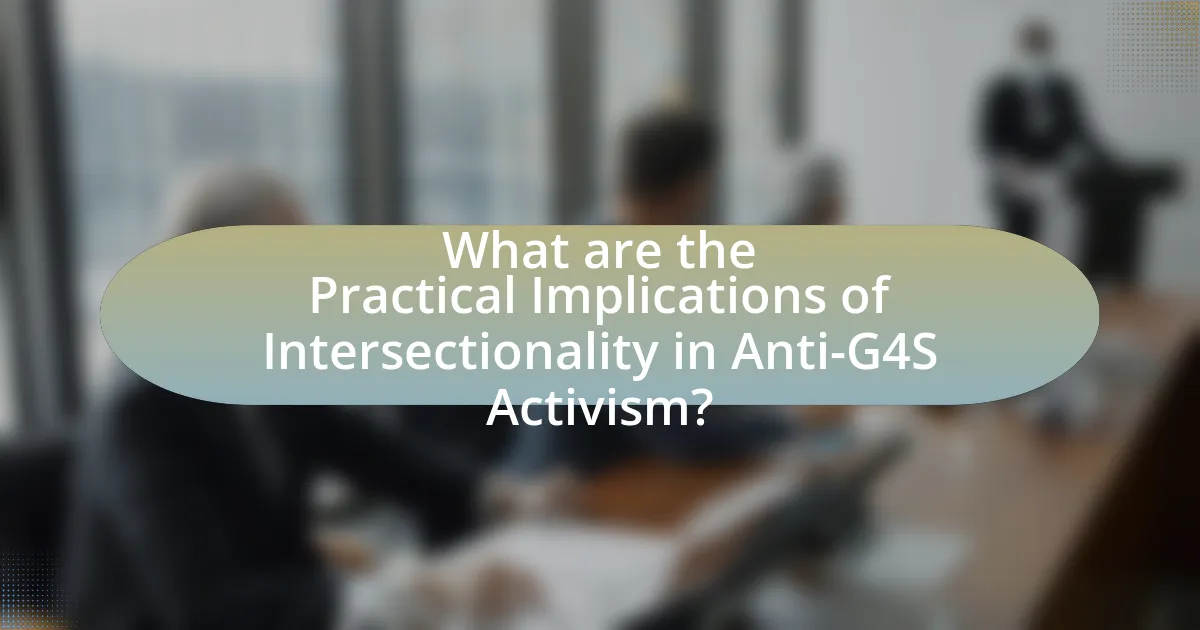
What are the Practical Implications of Intersectionality in Anti-G4S Activism?
The practical implications of intersectionality in anti-G4S activism include the need for a multifaceted approach that addresses the diverse experiences of marginalized communities affected by G4S’s operations. This approach recognizes that issues such as race, gender, class, and immigration status intersect, influencing how individuals experience state violence and corporate complicity. For instance, anti-G4S campaigns that incorporate intersectional perspectives can better advocate for the rights of those disproportionately impacted, such as refugees and people of color, thereby fostering solidarity among various activist groups. Research indicates that intersectional activism can lead to more effective strategies and broader coalitions, as seen in movements that successfully challenged systemic injustices by highlighting interconnected oppressions.
How can intersectionality shape campaign strategies against G4S?
Intersectionality can shape campaign strategies against G4S by ensuring that the diverse experiences and identities of affected communities are represented and addressed. Campaigns that incorporate intersectional analysis can identify how factors such as race, gender, class, and immigration status intersect to create unique vulnerabilities to G4S’s practices, such as privatized policing and detention services. For example, research indicates that marginalized groups, including people of color and low-income individuals, are disproportionately impacted by G4S’s operations, which can be highlighted in targeted messaging and coalition-building efforts. By centering the voices of those most affected, campaigns can develop more effective strategies that resonate with a broader audience and foster solidarity among various social justice movements.
What role do marginalized voices play in anti-G4S campaigns?
Marginalized voices play a crucial role in anti-G4S campaigns by highlighting the intersectional impacts of G4S’s operations on vulnerable communities. These voices bring attention to issues such as racial profiling, immigration enforcement, and the privatization of public services, which disproportionately affect marginalized groups. For instance, activists from communities directly impacted by G4S’s actions often share personal testimonies that illustrate the human cost of corporate practices, thereby fostering empathy and solidarity among broader audiences. This inclusion of diverse perspectives not only enriches the narrative but also strengthens the campaign’s legitimacy and effectiveness by ensuring that the experiences of those most affected are central to the discourse.
How can intersectional analysis inform policy advocacy?
Intersectional analysis can inform policy advocacy by highlighting the diverse and overlapping identities that individuals possess, which affect their experiences and needs. This approach allows advocates to develop more inclusive policies that address the specific challenges faced by marginalized groups, such as women of color or LGBTQ+ individuals. For example, research by the American Psychological Association indicates that intersectional frameworks can lead to more effective interventions by recognizing how factors like race, gender, and socioeconomic status interact to shape individuals’ realities. By incorporating intersectional analysis, policy advocacy can ensure that solutions are equitable and responsive to the complexities of social identities, ultimately leading to more effective and just outcomes.
What best practices should activists adopt for intersectional engagement?
Activists should adopt inclusive collaboration, prioritize marginalized voices, and educate themselves on various identities for effective intersectional engagement. Inclusive collaboration involves forming alliances with diverse groups to amplify collective efforts, as seen in movements like Black Lives Matter, which integrates various social justice issues. Prioritizing marginalized voices ensures that those most affected by systemic oppression lead the conversation, fostering authenticity and relevance in activism. Additionally, continuous education on the complexities of race, gender, class, and other identities equips activists with the necessary understanding to address intersectional issues effectively, as highlighted by the research conducted by Crenshaw in “Mapping the Margins,” which emphasizes the importance of recognizing overlapping social identities in activism.
How can activists ensure inclusivity in their initiatives?
Activists can ensure inclusivity in their initiatives by actively engaging diverse communities and incorporating their perspectives into decision-making processes. This approach fosters a sense of belonging and representation, which is essential for effective activism. Research shows that initiatives that prioritize intersectionality, such as those highlighted in the “Intersectionality and Activism” report by Crenshaw (2017), demonstrate improved outcomes by addressing the unique challenges faced by marginalized groups. By creating platforms for dialogue and collaboration, activists can better understand and address the needs of various communities, ultimately leading to more equitable and impactful initiatives.
What tools and resources are available for intersectional activism?
Intersectional activism utilizes various tools and resources to address the interconnected nature of social categorizations. Key resources include online platforms like social media for awareness and mobilization, educational materials such as books and articles that explore intersectionality, and community organizations that provide support and networking opportunities. For instance, the “Intersectionality Toolkit” by the Center for Intersectional Justice offers practical strategies for activists. Additionally, funding opportunities from organizations like the Ford Foundation support intersectional initiatives, highlighting the importance of financial resources in sustaining activism. These tools and resources collectively empower activists to effectively advocate for marginalized communities by addressing multiple layers of oppression.
